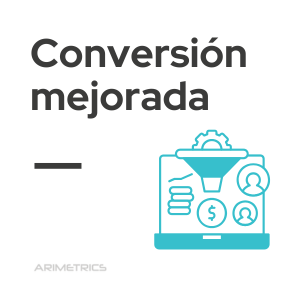Definition:
Enhanced conversion is an advanced strategy within conversion rate optimization (CRO) that seeks to increase the percentage of users who complete a desired action on a website or application, such as making a purchase, subscribing to a mailing list, or completing a form. Through enhanced conversion, companies not only optimize the visual and functional elements of their pages, but also integrate user data, personalization, and continuous testing to maximize the performance and effectiveness of their digital campaigns.
Features of Enhanced Conversion
- Focus on the user: Analyze and understand the motivations, barriers, and needs of visitors to personalize the experience.
- Data-driven optimization: Use advanced analytics and A/B testing to identify and validate changes that impact conversion.
- Improvement of the conversion funnel: Analyze each stage of the funnel to detect leakage points and opportunities for improvement.
- Content personalization: Adapt messages, offers, and visual elements according to the user’s profile and behavior.
- Mobile experience optimization: Ensure that the conversion process is smooth on all devices.
- Loading speed and usability: Improve loading time and ease of navigation to reduce abandonment.
- Trust and credibility: Incorporate elements such as testimonials, security seals, and clear policies to increase user confidence.
- Continuous iteration: Implement changes, measure results, and adjust the strategy constantly.
Advantages of Enhanced Conversion in Marketing
Enhanced conversion brings tangible and measurable benefits to any digital strategy:
- Increased revenue: By increasing the percentage of users who convert, the value of each visitor is maximized without increasing the investment in traffic.
- Reduction of acquisition cost: Improving conversion allows you to obtain more customers with the same advertising budget.
- Better user experience: An optimized site is more intuitive and satisfactory, which increases loyalty and recommendation.
- Data-driven decisions: Advanced analytics and testing allow you to make informed decisions and reduce the risk of counterproductive changes.
- Competitive advantage: A more efficient conversion process can differentiate you in saturated markets.
- Scalability: The implemented improvements can be replicated on other pages, campaigns, or digital channels.
How to Implement Enhanced Conversion
The implementation process of an enhanced conversion begins by identifying the key actions you want to optimize, such as buying a product or registering on a form. Next, it is essential to analyze the conversion funnel to detect at what points users abandon the process. Use web analytics tools to collect data on visitor behavior and conduct surveys or heat maps to understand their motivations and frustrations.
With this information, formulate hypotheses about possible improvements, such as simplifying forms, improving calls to action, or personalizing messages according to the user segment. Perform A/B tests to validate each change and measure the impact on the conversion rate. It is important to iterate continuously, adjusting the strategy according to the results obtained and the new trends in user behavior.
Common Use Cases of Enhanced Conversion
Enhanced conversion is applied in a wide variety of sectors and situations. In e-commerce, optimizing the product page and the checkout process can significantly increase sales. In B2B companies, improving contact forms and the quality of leads is essential to increase business opportunities. Digital media can increase newsletter subscriptions or event registrations by optimizing landing pages and personalizing messages.
It is also common to apply enhanced conversion in digital advertising campaigns, where small changes in creatives, texts, or calls to action can significantly impact results. Even in mobile apps, optimizing onboarding and user experience can translate into more downloads and greater retention.
Best Practices to Maximize its Benefits
To get the best results, it is recommended to:
- Adopt a user-centered approach: Actively listen to your visitors and adapt the experience to their real needs.
- Perform continuous tests: Do not settle for a single optimization, experiment and validate each change with data.
- Optimize for all devices: Make sure the conversion is simple and attractive on mobile, tablet, and desktop.
- Use personalization: Segment your users and adapt messages, offers, and content for each group.
- Monitor and analyze results: Use dashboards and reports to identify trends and opportunities for improvement.
- Promote trust: Include elements of social proof, guarantees, and clear policies to reduce friction and fear of error.
- Iterate and evolve: Enhanced conversion is a dynamic process, stay updated with the best practices and new tools in the sector.

